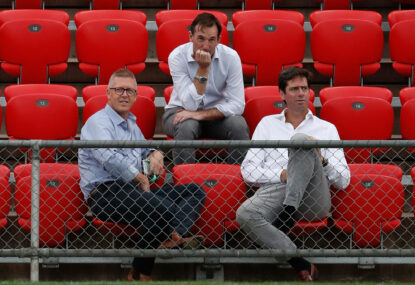The days of AFL being a only winter sport are all but behind us. In the days of old, the season wouldn’t kick off until the end of March, perhaps even the start of April.
And the players would slog it out over the winter months on grounds resembling little more than swamps.
Moorabbin and Glenferrie had particularly muddy reputations. Concerns about playing in the heat were unheard of.
But those days are gone.
Footy continues to encroach upon the cricket season and with games played in all corners of the country from mid-February onwards.
Anxiety about playing in extreme heat has begun to permeate the sport at the top level.
But how serious an issue is it? Dehydration and heat stroke are at best unpleasant and at worst life threatening. But with the scientific approach to players’ preparation, superior fitness, mass rotations, ice vests, fans on the boundary and extended benches, are our players really at risk?
The AFL mustn’t think so as it continues to schedule games in summer and in parts of the country renown for their hot climates and the clubs, apart from a few half hearted moans about restricted rotations for the coming rounds of the NAB cup series, haven’t pressed the AFL too heavily on the matter.
For the most part it appears to be a non-issue.
Sport is played in hostile climates throughout the world and most participants live to tell the tale. In fact only a handful of heat related incidents at elite level come to mind, and the fact that they are remembered so easily is because they are largely unique.
Cricket has been played in the steaming cauldron of the sub-continent for years. While not as physically brutal as football, the players spend long hours in the sun with little respite from the unrelenting heat.
You would expect the history of cricket to be littered with heat related incidents, yet apart from the seriously distressed Dean Jones after he batted heroically to score 210 at the 1986 tied Test in Chennai, India, only the most ardent cricket follower would be able to rattle off any others.
The marathon, another endurance sport that demands more of its participants than we mere mortals can ever understand, has also been run under severe conditions.
Images of Gabriela Andersen-Schiess completing an agonising final lap of the arena at the 1984 Los Angeles Olympics made front pages around the world. Heat exhaustion had twisted her body and reduced her gait to nothing more than a swerving stagger.
It took her six minutes to complete that final lap.
It was the first time a women’s marathon had been held at Olympic level, but it didn’t deter organisers from including it at subsequent games.
While we may see exhausted athletes withdraw from marathons en route, scenes like those surrounding Anderson-Schiess are rare.
The other famous one was Dorando Pietri who fell five times on his final lap and was disqualified after being assisted to the line at the 1908 London games.
Cycling, a sport that can have its athletes pedalling away on their bikes for upward of six hours at a time, holds its most famous and perhaps most gruelling three week race during the height of the French summer.
The Tour de France tackles some of Europe’s most arduous climbs and it is not unusual for these stages to be held in tarmac melting temperatures.
Not only do the cyclists endure, they saddle up again to do it all again the next day, and the next, and the next. No five, six or seven day breaks for them.
That’s not to say cycling hasn’t had its heat related incidents. The 1955 Tour climbed the dreaded Mont Ventoux in extreme temperatures that saw one cyclist (Jean Mallejac) collapse on its slopes and most others, including Australia’s own Russell Mockridge, raiding nearby farmhouses for water and relief.
French hero Louison Bobet lay on his bed afterward declaring that he could not go on – but he did, and he won.
Twenty two years later Britain’s Tom Simpson died on the slopes of the same mountain. While drugs played their role in Simpson’s demise, the extreme heat was also a contributing factor.
Anyone who has sat court side at the Australian Open on a stinking hot January day will also know what it is like to be baked alive. The on court temperature must be so oppressively energy sapping, and yet the players play on.
There are heat policies, but it has to be extremely hot before they are enacted.
These are just some of the incidents that come readily to mind. Of course there are more, but they are not as common as you might think.
These incidents are rare because the athletes train for their chosen sport and take precautions to minimise the dangers presented by outside factors such as the weather.
Of the sports mentioned above, the AFL is best placed to protect its players against any harm caused by extreme heat. Unlike the others, it alone has the capacity to rotate its players throughout the day and keep them cool while they are on the boundary.
Player’s hydration and body weight are monitored so if some are experiencing distress during or after a game, they can instantly be set on the correct path of recovery, minimising any long term health effects and ensuring that the player returns to ‘normal’ as soon as possible.
From the late 1990s through to the early 2000s, I played football for several years in the Pilbara and Kimberley regions of far north Western Australia. Games were regularly played in temperatures of 35 degrees or more.
Although lacking the high level pressure of the sport at AFL level, the games were still intense, hard fought, passionate affairs.
Despite a much lower level of fitness and without the scientific data and support staff to look after their welfare, the boys still managed to play out games strongly and be ready for work Monday morning. And this was every week, not just once or twice a year.
While there is nothing wrong with today’s players wanting a safe work place and the best possible conditions to play in, they have to accept that football is an outside (mostly) sport and that like the surface of the grounds and the quality of the opposition, the weather conditions will change.
Sometimes that means playing in the heat. But don’t panic – the odds say that they will probably be ok.


































































































